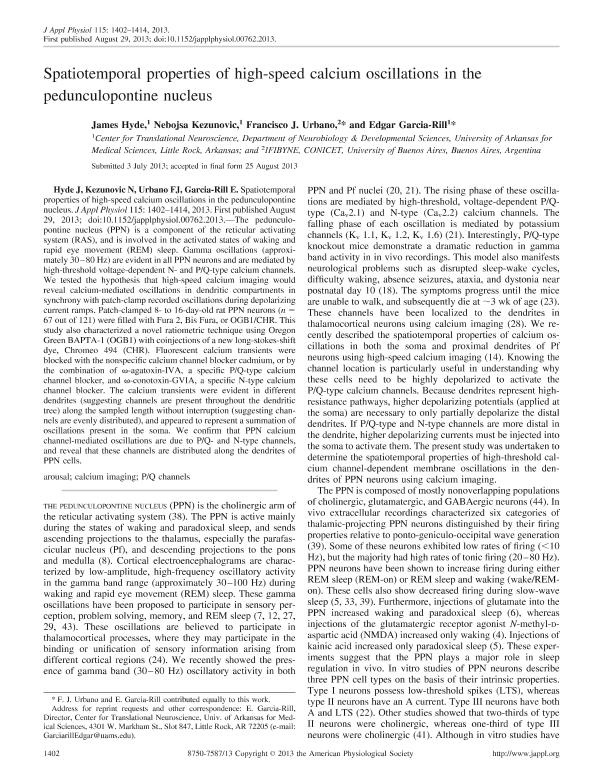Artículo
Spatiotemporal properties of high-speed calcium oscillations in the pedunculopontine nucleus
Fecha de publicación:
11/2013
Editorial:
American Physiological Society
Revista:
Journal Of Applied Physiology
ISSN:
8750-7587
e-ISSN:
1522-1601
Idioma:
Inglés
Tipo de recurso:
Artículo publicado
Clasificación temática:
Resumen
The pedunculopontine nucleus (PPN) is a component of the reticular activating system (RAS), and is involved in the activated states of waking and rapid eye movement (REM) sleep. Gamma oscillations (approximately 30–80 Hz) are evident in all PPN neurons and are mediated by high-threshold voltage-dependent N- and P/Q-type calcium channels. We tested the hypothesis that high-speed calcium imaging would reveal calcium-mediated oscillations in dendritic compartments in synchrony with patch-clamp recorded oscillations during depolarizing current ramps. Patch-clamped 8- to 16-day-old rat PPN neurons (n = 67 out of 121) were filled with Fura 2, Bis Fura, or OGB1/CHR. This study also characterized a novel ratiometric technique using Oregon Green BAPTA-1 (OGB1) with coinjections of a new long-stokes-shift dye, Chromeo 494 (CHR). Fluorescent calcium transients were blocked with the nonspecific calcium channel blocker cadmium, or by the combination of ω-agatoxin-IVA, a specific P/Q-type calcium channel blocker, and ω-conotoxin-GVIA, a specific N-type calcium channel blocker. The calcium transients were evident in different dendrites (suggesting channels are present throughout the dendritic tree) along the sampled length without interruption (suggesting channels are evenly distributed), and appeared to represent a summation of oscillations present in the soma. We confirm that PPN calcium channel-mediated oscillations are due to P/Q- and N-type channels, and reveal that these channels are distributed along the dendrites of PPN cells.
Palabras clave:
Arousal
,
Pedunculopontine
,
Calcium Imaging
,
P/Q Type Calcium Channels
Archivos asociados
Licencia
Identificadores
Colecciones
Articulos(IFIBYNE)
Articulos de INST.DE FISIOL., BIOL.MOLECULAR Y NEUROCIENCIAS
Articulos de INST.DE FISIOL., BIOL.MOLECULAR Y NEUROCIENCIAS
Citación
Hyde, James; Kezunovic, Nebojsa; Urbano Suarez, Francisco Jose; Garcia Rill, Edgar; Spatiotemporal properties of high-speed calcium oscillations in the pedunculopontine nucleus; American Physiological Society; Journal Of Applied Physiology; 115; 9; 11-2013; 1402-1414
Compartir
Altmétricas




